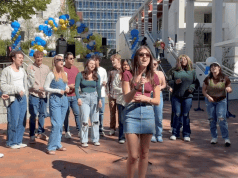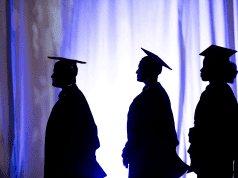Dr. Andrew Butler and his colleagues work daily with products and services designed to increase motor function and aid rehabilitation of stroke survivors.
But one innovative product caught his eye as an effective tool.
The Associate Professor of Rehabilitation Medicine at Emory is a neuroscientist and physical therapist and 2009 EMBA graduate of Goizueta Business School. He has worked with Kinetic Muscles, Inc. and his research lab has purchased and used Kinetic Muscles products over the last decade.* Kinetic Muscles, a healthcare technology start-up company based in Tempe, Ariz. produces the Hand Mentor™, an in-home, upper-limb robotic device that communicates therapy progress back to medical providers to aid in stroke recovery.
According to the National Stroke Association, more than 795,000 strokes will strike men and women this year. Approximately 137,000 of these individuals will die, making stroke the third-leading cause of death in the United States. In addition, some 50 to 60 percent of stroke survivors exhibit some degree of motor impairment and require at least partial assistance in activities of daily living. According to Dr. Butler, the most common impairments that limit functional status post-stroke are upper limb motor function.
Dr. Butler knows thousands of stroke survivors can benefit from Kinetic Muscles’ Hand Mentor™ and similar products if they knew more about the technology and its benefits. The Hand Mentor™ creates an interactive training environment that helps improve hand function with various physical therapy programs. After conversations with Kinetic Muscles’ CEO Grant Farrell, he looked to build a bridge between rehabilitation science and business.
What followed was a valuable project for MBA and undergraduate students.
Long-time Goizueta Business School marketing professor Dr. Ed Leonard introduced Dr. Butler to Dr. Ashish Sood, an Assistant Professor of Marketing. A “live” project was born last fall whereby Goizueta students worked directly with Kinetic Muscles to develop plans for marketing its unique products.
At Goizueta, Dr. Butler and Kinetic Muscles executives worked with Full-Time and Evening MBA and undergraduate students learning marketing strategy under the guidance of Dr. Sood. Students were eager to help the startup and offered immediate energy and creativity.
According to Dr. Sood, the project addressed the problem of offering low-cost medical technologies to more people. The business school and Emory School of Medicine continue to work in tandem on similar issues and Goizueta offers various dual degrees including an MBA and Doctor of Physical Therapy. Other “live” projects in marketing and other academic areas cross schools. Goizueta offers additional classes in the aspects of healthcare business.
“Every year many students from the School of Public Health and School of Medicine take courses in business at the Goizueta Business School,” Said Dr. Sood.
“This is synergistic with what we do here at Emory,” Dr. Butler said.
Students generated a plethora of ideas ranging from social media strategy to reach caregivers and others impacted by stroke, to increasing traffic on Kinetic Muscles’ web properties, to gathering numbers on cost benefits for healthcare companies that sign on to use Kinetic Muscles’ rehabilitation products.
[youtube JdH2nlaTTgw]
“Students were asked to develop a marketing and sales strategy to ensure successful adoption and growth of this exciting new therapy delivery service,” added Dr. Sood. “Multiple teams worked on different aspects of marketing strategy including market entry strategy, alliance strategy, positioning strategy, competitor analysis, branding strategy, pricing strategy, value proposition strategy, and new product diffusion strategy.”
Increasing product recognition was also a key, to which students elected to communicate to family members (often caregivers) and stroke survivors directly. One group developed an innovative plan to place informational kiosks in shopping malls to reach those charged with long-term care of stroke survivors. Another team developed an interactive website that builds on the latest social media technologies to enhance patient-doctor-caregiver engagement and interactivity.
“Marketing drives what we’re trying to do not only on the education level but in research and service delivery,” Dr. Butler said. “There are at least three different models in there that we continue to build. I have nothing but positive things to say about what we’ve done so far and there are a lot of interesting things in the future.
“We’re not looking at the way marketing has been done in the past. [Students] really pushed the envelope; they’re looking at new things.”
Ed Koeneman, Chief Operating Officer at Kinetic Muscles, was pleased with the presentations from the 18 student groups.
“They looked at our marketing strategy in ways we’ve never thought of before,” he said.
“It isn’t everyday that undergraduate students are asked to develop viable, fiscally responsible marketing campaigns for up-and-coming companies,” added Ross Godick (11BBA), an undergraduate who worked on a project to determine feasibility for domestic and international expansion. Not only was it rewarding to see executives interested in our ideas, but it was also extremely exciting to learn about the cutting-edge healthcare technology that is currently being developed.”
Elaine Perez (12EvMBA), a graduate student who provided Kinetic Muscles with competitor analysis, said the experience was a chance to find an answer for a current problem, not read the history of one already solved.
“As beneficial as business cases can be, they look backward so you have dated material and an ‘answer’ for what the company did and how well it worked,” she said. “In the Kinetic Muscles project, we were working with current material and looking forward. It opens up a new set of possibilities when you haven’t been given a defined set of information that leads to an ideal solution.”
Work from student projects is invaluable to a company like Kinetic Muscles which, according to Koeneman, is a startup company with big goals.
“The basic science is that stroke survivors can make tremendous advances and improve their quality of life tenfold if they can get access to the proper rehabilitation; that’s the challenge,” Koeneman said.
Dr. Sood said his students showed increased interest and passion for the project because of its potential to help patients and families – the chance to make a difference.
“What I saw was a much higher level of enthusiasm and effort to create feasible solutions for Kinetic Muscles based on many theoretical concepts and quantitative techniques the students had learned in class. ” he said. “Students were motivated to really make a difference and saw the value of this ‘live’ project… That’s what excited them.
“Such real-life projects complement the solid academic foundation with a broader perspective.”
Instructors say this is just one of many “live” projects to cross between the Goizueta Business School and the School of Medicine which directly affect real-world technologies and practices. Students can also expect more involvement with Kinetic Muscles through project execution.
“When these students check in on Kinetic Muscles’ progress, they are bound to see their suggestions manifested on the website or in the marketing materials,” added Koeneman “They will have the satisfaction of knowing that their ideas were taken seriously and that they had an impact on a startup company on the road to success.”
*DISCLAIMER: Dr. Butler has no financial interest in Kinetic Muscles.











[…] This post was mentioned on Twitter by Goizueta Admissions, Goizueta Newsroom. Goizueta Newsroom said: Students Take Role in Marketing Healthcare Technology Start-Up http://goo.gl/fb/9Prg5 #goizueta […]